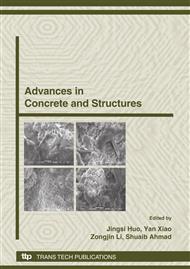p.471
p.477
p.483
p.491
p.501
p.507
p.513
p.519
p.525
Repairing Bridges in Coastal Area with Ba Bearing Sulphoaluminate Cement
Abstract:
In coastal areas, corrosion has been found in bridge piers made of Portland cement concrete. In an trail to protect the piers from further damages, Ba bearing sulphoaluminate cement concrete was tested as the repairing layers. It is showed that the Ba bearing sulphoaluminate cement concrete has a lower porosity and a more compact structure than Portland cement concrete under the same conditions, and consequently, better performances, such as high strength and corrosive resistance both in lab and real corrosive environments. Stimulating experiments indicate that Ba bearing sulphoaluminate cement is more suitable for repairing bridges in coastal area.
Info:
Periodical:
Pages:
501-506
Citation:
Online since:
October 2008
Authors:
Price:
Сopyright:
© 2009 Trans Tech Publications Ltd. All Rights Reserved
Share:
Citation:


